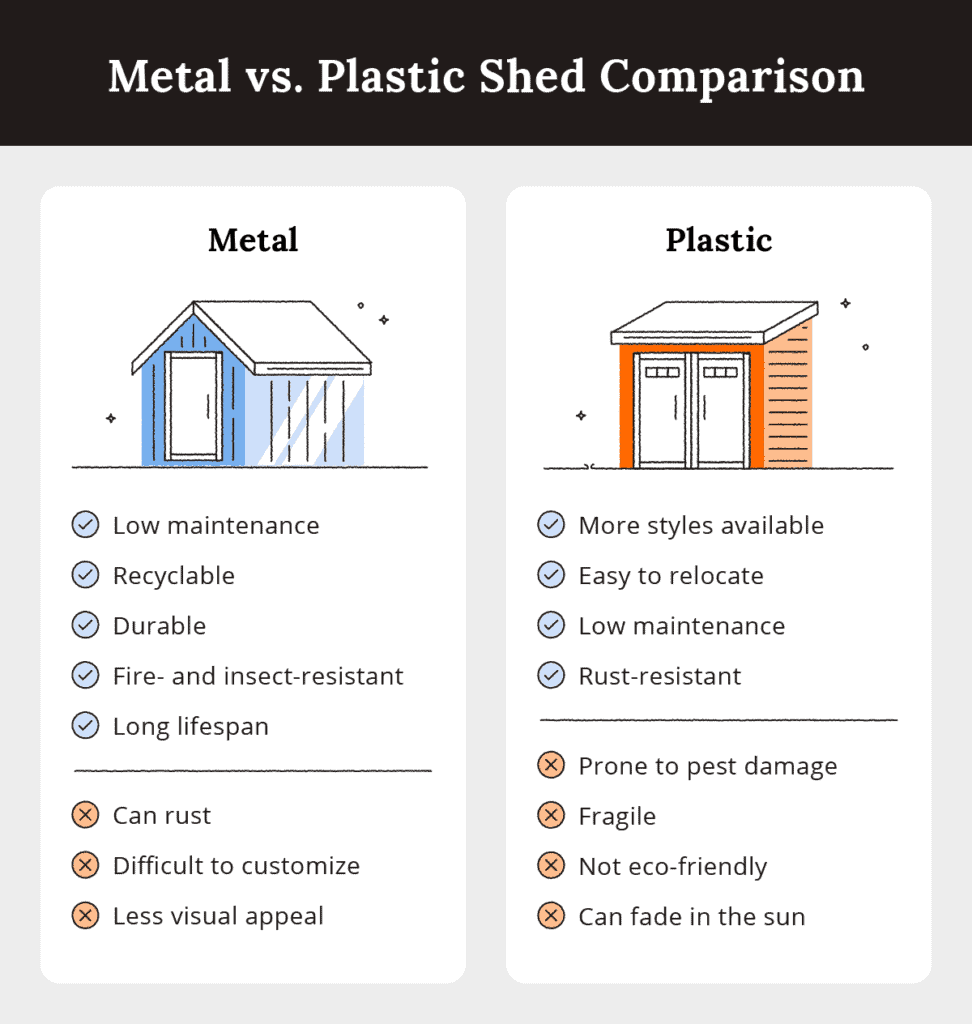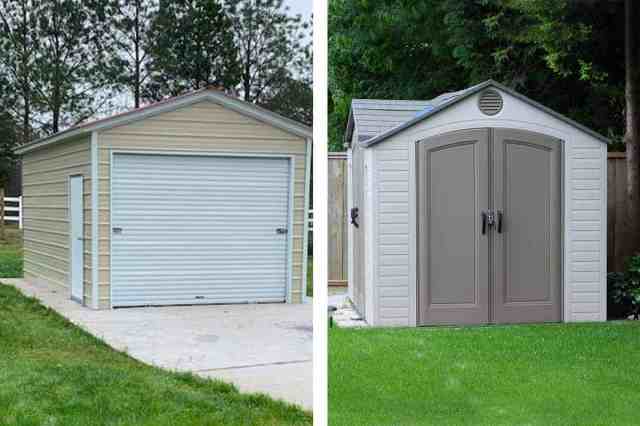Before investing in a good storage shed, choosing the best material for your shed is important. Most sheds are available in wood, metal, or plastic. But which material is the best?
Each material has pros and cons depending on where you live and how you plan to use the shed. This guide will help determine whether metal, plastic, or wood sheds better serve your budget and storage needs.
Metal Sheds
If you are cost-conscious, metal sheds give you the most value for your dollar. Metal is relatively low-maintenance and extremely durable. The material is both fire- and insect-resistant and can withstand strong winds and weather conditions. When properly maintained, a metal shed with good insulation can last over 100 years. Should you decide to get rid of your shed someday, metal is also recyclable.
As for maintenance, the main thing you’ll need to do is perform an annual inspection to help you spot and prevent rust development. If any rust spots appear on the metal, sand it down and touch up the spot with rust-resistant paint.
You can find smaller shed sizes at your local home improvement store or online. For larger sheds (12’x20’ or more), you can custom order them for delivery here on our website.
Pros:
- Low maintenance
- Fireproof
- Durable
- Long-lasting
- Insect-resistant
- Recyclable
Cons:
- Difficult to customize
- Considered less appealing by some people
- Can rust if not properly maintained
Plastic Sheds
Plastic sheds, also known as “vinyl” sheds, are quick and simple storage options. Most are readily available at local home improvement stores, where you can buy them as kits to assemble on your own. They’re also easy to maintain—you only need to wash them with soap and water periodically.
The downside is that plastic sheds can quickly fade in color from sun exposure and deteriorate over time. Even if you hire a shed removal service, it’s also harder to dispose of plastic sheds because the material is not environmentally friendly. Plastic is usually defensive against insects, but certain pests can still chew through and damage it.
Pros:
- Low-maintenance
- Easy to install
- Rust-resistant
- Insect-resistant
- Portable
Cons:
- Less customizable
- Fade over time
- Not environmentally friendly
- Flimsy
Wood Sheds
Since wood is an easier material to customize, most people choose wood sheds for their appearance. Many wood sheds have windows, shutters, and other accessories. Wood is a bit more durable than plastic but not as strong or long-lasting as metal.
The downside to wood is that it’s prone to wood-eating insects and pests, such as termites. It can also warp and rot over time, so you should apply waterproof treatment and perform maintenance more frequently than plastic and metal sheds.
Check out our full metal vs. wood shed guide for a more in-depth comparison.
Key Differences Between Metal and Plastic Sheds

Before buying a new shed, you’ll want to determine its purpose. For example, will you only need it for storage, or do you plan to convert the shed into a multipurpose structure? Below is a helpful breakdown of other important factors to consider.
Cost
The average cost of a shed is $2,500. The exact price depends on the size, style, and customizations. That said, plastic material is slightly cheaper than metal. It’s helpful to have a budget in mind, including how much you’re willing to spend on customizations.
Appearance
While you can find different types of shed styles made of metal and plastic, there is generally more variety in plastic sheds.
Maintenance
After installation, plastic and metal sheds require minimal maintenance. You only need to power wash your shed to remove dirt and debris. To help with longevity, you may need to add a rust-preventative coating to your metal shed and a sealant to your plastic shed to prevent cracks.
Durability
Metal sheds can withstand weather conditions and are highly resistant to damage. Plastic, on the other hand, is much weaker and loses its shape over time.
Customizability
Metal and plastic sheds are both hard to customize after installation. Simple changes, such as painting the shed, are possible, but other changes such as drilling can potentially damage these materials.
How to Choose The Right Shed for You
When investing in a shed, make sure you’re choosing a material that is durable for your location, climate, and use. A plastic shed may make sense if you just need an inexpensive, temporary place to store your stuff.
On the other hand, for a stronger and longer-lasting shed, metal is your best bet. Metal sheds are designed to withstand rough weather conditions and are less prone to damage.
Here at Alan’s Factory Outlet, you can customize and personalize a metal shed by choosing from a wide range of colors, styles, and sizes. Use our tool below to design and order your new shed today.




